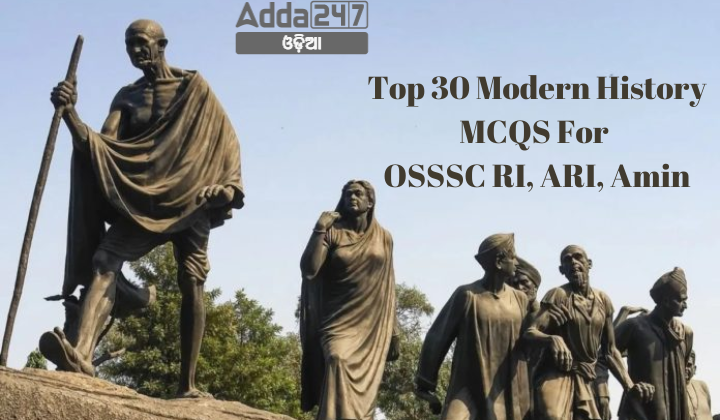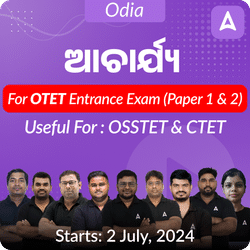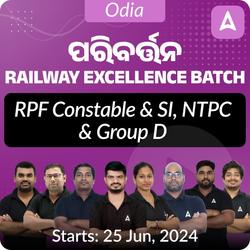Preparing for competitive exams such as OSSSC RI (Revenue Inspector), ARI (Assistant Revenue Inspector), Amin, SFS, or ICDS Supervisor often requires a strong grasp of historical events. Modern history, especially, forms a significant part of the syllabus, covering crucial periods and events that shaped the world as we know it today. To aid in your preparation, here are 30 multiple-choice questions (MCQs) focusing on modern history:
Top 30 Modern History MCQs for OSSSC RI,ARI, Amin, SFS, ICDS Supervisor
- Who proposed the Permanent Settlement system in 1786?
(a) Warren Hastings
(b) Lord Cornwallis
(c) William Pitt
(d) Robert Clive
Ans: (b) Lord Cornwallis - When did the Permanent Settlement Act come into effect?
(a) 1786
(b) 1790
(c) 1793
(d) 1800
Ans: (c) 1793 - Under the Permanent Settlement, who were recognized as the owners of the land?
(a) Farmers
(b) British Officials
(c) Zamindars
(d) Merchants
Ans: (c) Zamindars - What was the fixed revenue share that the landlords had to pay to the government?
(a) 1/11th
(b) 2/11th
(c) 9/10th
(d) 10/11th
Ans: (d) 10/11th - Which British official experimented with the annual settlement of land before the Permanent Settlement?
(a) Lord Cornwallis
(b) Warren Hastings
(c) William Pitt
(d) Robert Clive
Ans: (b) Warren Hastings - What document was the Zamindar required to give to the tenant describing the land and rent?
(a) Patta
(b) Sanad
(c) Farman
(d) Firman
Ans: (a) Patta - Which major event in 1770 partly occurred due to the Company’s neglect in revenue collection?
(a) Battle of Buxar
(b) Bengal Famine
(c) Battle of Plassey
(d) Sepoy Mutiny
Ans: (b) Bengal Famine - What was one of the merits of the Permanent Settlement?
(a) Increased tax revenue
(b) Security for all parties involved
(c) Less burden on Zamindars
(d) Complete British control over land
Ans: (b) Security for all parties involved - Which of the following was a demerit of the Permanent Settlement?
(a) Improved agricultural practices
(b) Creation of a class of aristocratic landlords
(c) Fixed and fair revenue assessment
(d) Equal distribution of land revenue
Ans: (b) Creation of a class of aristocratic landlords - In what year did the British government warn against imposing permanent settlement without a proper land survey?
(a) 1800
(b) 1805
(c) 1811
(d) 1820
Ans: (c) 1811 - This system of land revenue was instituted in the late 18th century by Sir Thomas Munro, Governor of Madras in 1820.
(a) Zamindari System
(b) Mahalwari System
(c) Ryotwari System
(d) Permanent Settlement
Ans. (c) Ryotwari System - In which areas was the Ryotwari system practiced?
(a) Bengal and Bihar
(b) Punjab and Sindh
(c) Madras and Bombay
(d) Orissa and Gujarat
Ans. (c) Madras and Bombay - Who were regarded as the owners of the land in the Ryotwari system?
(a) Zamindars
(b) British officials
(c) Peasants or cultivators
(d) Village headmen
Ans. (c) Peasants or cultivators - What was the percentage of tax rates in the Ryotwari system for dryland and wetland respectively?
(a) 30% and 40%
(b) 40% and 50%
(c) 50% and 60%
(d) 60% and 70%
Ans. (c) 50% and 60% - What problem arose due to high taxes being paid only in cash under the Ryotwari system?
(a) Increase in food crops
(b) Emergence of moneylenders
(c) Decline in village headmen
(d) Abundance of middlemen
Ans. (b) Emergence of moneylenders - The Mahalwari system was introduced by Holt Mackenzie in 1822 and reviewed under which governor in 1833?
(a) Lord Wellesley
(b) Lord Dalhousie
(c) Lord Cornwallis
(d) Lord William Bentinck
Ans. (d) Lord William Bentinck - In the Mahalwari system, the land was divided into units known as:
(a) Villages
(b) Estates
(c) Mahals
(d) Districts
Ans. (c) Mahals - What percentage of the rental value was the state share of the revenue in the Mahalwari system?
(a) 33%
(b) 50%
(c) 66%
(d) 75%
Ans. (c) 66% - Which system of land revenue was known as the Modified Zamindari system?
(a) Zamindari System
(b) Ryotwari System
(c) Mahalwari System
(d) Permanent Settlement
Ans. (c) Mahalwari System - Which of the following was a consequence of the British land revenue systems?
(a) Decrease in bonded labour
(b) Increase in private ownership of land
(c) Decrease in food insecurity
(d) Reduction in moneylenders’ influence
Ans. (b) Increase in private ownership of land - Which oppressive practices did Raja Ram Mohan Roy condemn in his economic reforms?
(a) British trade monopolies
(b) Bengali zamindars
(c) Indian merchants
(d) British export policies
Answer: (b) Bengali zamindars - What did Raja Ram Mohan Roy demand in terms of rent fixation?
(a) Complete abolition of rent
(b) Increase in rent prices
(c) Fixation of minimum rents
(d) Rent to be paid in kind
Answer: (c) Fixation of minimum rents - Raja Ram Mohan Roy called for the abolition of which trading rights?
(a) British merchant trading rights
(b) Dutch East India Company’s trading rights
(c) French East India Company’s trading rights
(d) East India Company’s trading rights
Answer: (d) East India Company’s trading rights - What was one of the major reforms Raja Ram Mohan Roy advocated for in the press?
(a) Increased government control
(b) More advertisements
(c) Restrictions on foreign news
(d) Freedom of the press
Answer: (d) Freedom of the press - Which journal did Raja Ram Mohan Roy NOT establish?
(a) The Brahmanical Magazine
(b) Samvad Kaumudi
(c) Mirat-ul-Akbar
(d) The Hindu
Answer: (d) The Hindu - What was one of Raja Ram Mohan Roy’s demands in administrative reforms?
(a) Reduction of British salaries
(b) Indianisation of superior services
(c) Elimination of all British officials
(d) Increase in British judicial power
Answer: (b) Indianisation of superior services - Which association did Raja Ram Mohan Roy form in 1828 to promote religious and social reforms?
(a) Atmiya Sabha
(b) Calcutta Unitarian Association
(c) Brahmo Sabha or Brahmo Samaj
(d) Indian Social Reform Association
Answer: (c) Brahmo Sabha or Brahmo Samaj - What significant social evil did Raja Ram Mohan Roy campaign against, which was abolished in 1829?
(a) Child marriage
(b) Polygamy
(c) Caste system
(d) Sati
Answer: (d) Sati - Raja Ram Mohan Roy’s educational reforms included support for the establishment of which college?
(a) Presidency College
(b) Hindu College
(c) St. Xavier’s College
(d) University of Calcutta
Answer: (b) Hindu College - Which of the following beliefs did Raja Ram Mohan Roy NOT advocate?
(a) Monotheism
(b) Idol worship
(c) Rationalism
(d) Scientific approach
Answer: (b) Idol worship










